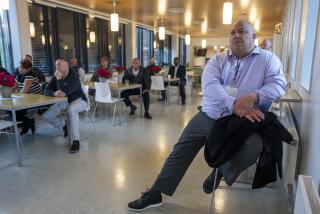Suspect in Norway attacks is denied public platform in court
Reporting from Oslo — It was supposed to be a defining moment for Norwegian terrorism suspect Anders Behring Breivik.
He had hoped that Monday’s hearing into last week’s twin attacks would be televised live by the world’s media, authorities say. He wanted to dress in uniform to defend his actions as part of a bid to trigger an anti-Islamic revolution in Europe.
But to his disappointment, Breivik’s much-anticipated first court appearance was neither seen nor heard by the public. A Norwegian judge ruled that the proceedings should be held behind closed doors, siding with prosecutors who are increasingly nervous about giving the suspect a forum to espouse his radical views.
Inside the courtroom, Breivik was said to have listened calmly as he was formally charged with violating Norway’s anti-terrorism laws and remanded to solitary confinement for the next four weeks.
During a media briefing after the hearing, Judge Kim Heger said Breivik confessed to the attacks — which police now say killed 76 people, rather than the previously reported toll of 93 — but pleaded not guilty to the terrorism charges, justifying his actions as part of an anti-Muslim campaign.
The 32-year-old suspect also claimed to be working with two cells, although police say previously he told them he acted alone. Norwegian officials said it remains unclear whether Breivik is part of a wider conspiracy or is a lone megalomaniac.
But as more is learned about Breivik, through friends, family and a 1,500-page manifesto he released on the Internet, it seems likely that he is relishing the attention being focused on his life and ideas.
His manifesto, released shortly before Friday’s violence, refers to attacks like the bombing in downtown Oslo and the hourlong shooting massacre at a youth political camp retreat as a “marketing” tool designed to focus international attention on his extremist ideology.
“Unfortunately, I don’t think he’s crazy,” said Peter Svaar, a childhood friend of Breivik’s. “He’s cold, intelligent and resourceful. He’s playing us all like a piano.”
Svaar, a journalist at Norwegian broadcaster NRK, said he believes Breivik is only halfway through a carefully planned “ideological operation” in which he hopes to use his arrest and trial to disseminate his “sick political analysis.” He noted that in addition to the lengthy manifesto, Breivik also produced and released a 12-minute video now circulating on YouTube and a Facebook page that “basically serves as his press kit.”
The manifesto is a mix of historical analysis, ideology and a personal diary, detailing his efforts over several years to buy weapons and bomb-making materials, experiment with explosives and create a double life to shield his activities from family, friends and government officials.
While Breivik portrays himself as a modern-day crusader, fighting against what he calls the Islamic invasion of Europe, he appears to have plagiarized some of his ideas.
Several sections are lifted directly from the writings of Unabomber Theodore Kaczynski, though Breivik replaces Kaczynski’s condemnation of “leftism” with his own pet peeves: “cultural Marxism” and “multiculturalism.”
“I’m not sure I would call this guy an intellectual,” said Anders Ravik Jupskas, political analyst from the University of Oslo, who noted that the treatise, written in English, is filled with grammatical errors.
“He’s more of a copycat,” Jupskas said. “It’s easy these days to take stuff from the Internet. The manifesto is a kind of erratic mix of different genres. He tries to present himself as a crusader and part of a long tradition. But the police need to verify some of the claims. Some of it might be part of his imagination.”
In his writings, Breivik describes growing up in a relatively happy, affluent, yet broken home. He writes of his interest in hip-hop and break dancing, but says he rejected the skinhead movement because he didn’t like the “dress code.”
In a candid, sometimes chatty tone, he portrays himself not as a loner or social outcast, but as someone who enjoys Red Bull and vodkas with friends, flirts with girls and bulks up on steroids.
A shopkeeper near the Oslo home of Breivik’s mother said she doted on her son, who lived with her for several years as an adult and often visited for dinner.
He refers to himself as a “laid-back type and quite tolerant on most issues.... As all my friends can attest to, I wouldn’t be willing to hurt a fly and I have never used violence against others.”
Of his flaws, he admits to being self-righteous, egotistical and arrogant.
Despite his xenophobic views, he writes appreciatively of Muslims at times, contrasting their loyalty to principles and religious devotion with his fellow Norwegians, who he says sometimes “sissy out” under pressure. Yet he refers frequently to “Muslim savages” and recounts eight alleged attacks against him by Muslim gangs.
He writes that at 16 he joined the anti-immigration Progress Party youth movement and became active in politics, but says he later quit after concluding that only a revolution could overturn the political system and stem the tide of Muslim immigration.
A turning point came after the 1999 NATO bombing of Yugoslavia. Breivik expressed sympathy with Serbian attacks against Muslims in Kosovo province, which has since gained independence.
In 2002, Breivik claims he took his first step in planning the attacks by attending a meeting of like-minded militants in London. He characterized the group as a new Knights Templar movement, a reference to the 11th century Christian group that fought during the Crusades to recapture the Holy Land.
He began to set up front companies to be used in gathering weapons and bomb-making materials, and distanced himself from friends and family.
“I guess I had a more normal life until I chose my current path,” he writes. “The path of the Justiciar Knight isn’t really compatible with that of person seeking to establish a family.”
Special correspondent Alexandra Sandels in Beirut contributed to this report.
More to Read
Sign up for Essential California
The most important California stories and recommendations in your inbox every morning.
You may occasionally receive promotional content from the Los Angeles Times.










